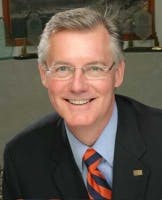Kids and cavity prevention
By V. Kim Kutsch, DMD, founder and CEO of CariFree© Dreamstime.com
The growing incidence of tooth decay in young children has become a national concern as the number of those children affected by dental caries continues to increase. According to data from the Centers for Disease Control and Prevention, dental caries — the oral biofilm dysfunction that causes cavities — is the No. 1 leading disease that affects children in the United States. Dental caries is so prevalent that it actually occurs five times more frequently than asthma, the second most common childhood disease in America. Unfortunately, many families are uneducated and unfamiliar with dental caries and its causes. They are unaware that cavities are actually caused by a preventable and treatable bacterial disease. As a result, many young children suffer from chronic pain and embarrassment associated with tooth decay.Several factors contribute to the onset of dental caries in children, the primary aspect being transmission of the disease. Through common acts of nurturing and childrearing, the mother or primary caregiver transfers the cariogenic bacteria to the infant. Originally thought to be one or two pathogenic bacteria, biofilm research now has identified numerous bacteria that play a role in causing dental caries. These bacteria have the common characteristic of thriving in acidic conditions. The vertical transmission of these acid-loving bacteria occurs from mother to child within the first few weeks of life, before the primary teeth have even erupted. In fact, the caries infection has been detected in children as young as 3 months old. Additionally, among other known risk factors, diet plays a major role in dental caries in children. Breastfeeding and bottle nursing can contribute to the disease process when breast milk or sugary or acidic liquids are given to the child on a frequent or at-will basis. It is not uncommon for families to disregard early childhood cavities and place a low priority on the primary teeth — the rationale being, once the baby teeth exfoliate, the cavities are gone and thus the problem is gone. Unfortunately, it is not that easy. Decay on primary teeth is an indication of the dental caries disease process. Although these teeth will be lost, the newly erupting permanent teeth are entering an environment where the disease process still exists. The cycle of cavities continues on the permanent teeth, and for many people dental decay becomes a lifelong, chronic experience. They see their dentist regularly and have their cavities treated, only to experience more cavities. The traditional surgical approach to treating this disease — the “drill and fill” model — has little or nothing to do with actually treating the disease. While it does provide the temporary benefits of pain relief and restoration of individual teeth to function, it does not address the cause of the cavities in the first place.As a profession we should stop asking “how many” cavities does a patient have, and start asking “why” do they have cavities in the first place ... and then correct the problem. New approaches need to be considered in treating dental caries. Based on known scientific evidence, CariFree has developed products that examine the behavior of the oral bacteria and actually correct the dysfunction of the biofilm to restore health and wellness. By correcting the biofilm, patients of all ages have a better chance to become and remain cavity-free for a lifetime. CariFree also aims to educate patients about the disease, or raise their “dental IQ,” so that families can make informed and appropriate health-care decisions for themselves. If one family member suffers from dental caries, it is commonly a family affair. As obesity levels also continue to rise in America’s youth, it is no surprise that the increase in cavities within this same demographic has become apparent. The constant consumption of sugary foods contributes not only to weight gain and diabetes, but also favors the cariogenic bacteria. While the caries-causing bacteria thrive in an acidic environment, it is not actually the sugar that causes the cavities, but the acid produced as a result of the metabolic breakdown of the sugars. This acidic condition, or prolonged periods of low pH, selects for the cariogenic bacteria and also drives the demineralization of the enamel and dentin, resulting in a net mineral loss from the teeth. This implies that other foods/liquids with a high acidic content (low pH), such as diet sodas, sparkling water, and juices — and not necessarily sugar — may also contribute to the development of the caries disease process. Sporadically consumed, these foods or drinks may not be harmful, but their consistent and continuous consumption does not allow the mouth’s pH balance to recover. It is this imbalance in pH, as a dysfunction of the biofilm that results in dental caries, that nets mineral loss and cavitation of the teeth. Dental caries is no longer considered a pathogen-specific disease, but is better described as a “pH specific” disease. Treatment strategies should include correcting the pH balance in the mouth. Recently, there have been several promising advances within the dental industry to help patients combat dental caries and create a cavity-free future. Xylitol, a 5-carbon sugar-alcohol, has proven extremely effective as an anti-caries agent. While the words, “sugar substitute” have been marred over the past decade, xylitol is significantly different. Not only is it completely natural and found in fruits, vegetables, and birch trees, but it is also naturally produced within our own bodies. Xylitol is not fermented by cariogenic bacteria and is not metabolized into acids like other sugars and sugar substitutes. This unique feature deters cariogenic bacteria and eventually leads to their demise. Furthermore, scientific studies indicate that xylitol potentiates even small amounts of fluoride. While brushing and flossing alone does not correct the biofilm dysfunction, fluoride used in conjunction with xylitol may be even more effective than using fluoride alone. Xylitol is also safe for children and comes in a wide variety of toothpastes, gums, rinses, and more.CariFree is a company that offers a range of cavity prevention products, including a line specifically designed with kids in mind. The company’s Xyli-Tots product line features everything from oral wipes and mouth sprays to lollipops. The kid-friendly products contain zero sugar and effectively regulate the mouth’s pH level by use of neutralizing agents and xylitol. The products are even safe for infants. By stopping the infection at a young age, children are given the opportunity to avoid a lifetime of chronic decay. Parents can also help decrease the spread of the caries disease by making sure that they are also screened and treated. And it’s never too early to prevent this disease. Studies have shown that mothers who chewed xylitol gum while pregnant greatly reduced the transmission of dental caries to their children. Nobody should have to suffer from the pain associated with chronic dental caries, especially our young children — and especially not when this is a preventable and treatable disease. Clearly the drill-and-fill approach is outdated and not working. Just adding fluoride and dental sealants hasn’t worked either. While continuous strides have been made to improve the oral care for patients of all ages, it is time that we recognize the need to approach dental caries by treating it at its roots. Companies like CariFree are committed to be a resource to the dental profession, and are committed to the education and treatment of patients so that they can attain a healthier life and a better future. In the past as a profession we have earned our living by treating cavities. It’s time we started earning our way by treating dental caries.
Dr. V. Kim Kutsch serves as chief executive officer and chief technical officer of Oral BioTech, manufacturers of the cavity prevention system known as CariFree. He received his DMD degree from the University of Oregon’s School of Dentistry in 1979. Lecturing extensively on an international basis, he also acts as product consultant and inventor for air abrasion, lasers, and adhesive and cosmetic dentistry. As well-published author, Dr. Kutsch has written dozens of articles and abstracts on minimally invasive dentistry, laser dentistry, dental caries, and biofilms in dental and medical journals. He has also contributed to several texts, served as an editorial staff member for Reality, and sits on the editorial board of several dental journals. In addition to his editorial work, Dr. Kutsch is a graduate and mentor for the prestigious Kois Center in Seattle. As an inventor, Dr. Kutsch holds numerous patents for air abrasion devices, powders, nozzles, and methods, as well as patents on cosmetic dental materials and methods. He is the former president of the International Academy of Laser Dentistry and the Academy of Laser Dentistry. Holding a Category III mastership in lasers in dentistry, he is a fellow of the American Society of Lasers in Medicine and Dentistry. He is also founder, fellow, diplomat, and first president of the World Congress of Minimally Invasive Dentistry. Additionally, Dr. Kutsch sits on the Board of Directors for the World Clinical Laser Institute and as a member of the ADA Dental Materials Laser Committee. He has served on the board of directors of the American Academy of Cosmetic Dentistry and University Relations Committee. Dr. Kutsch acted as founder and president of Kreativ Microdentistry Systems, which developed the first minimally invasive dentistry system. He also serves as an expert witness and regularly mentors dentists and dental study clubs on a variety of topics. He is a founding member of the Rendezvous annual dental meeting in Baker City, Ore. Dr. Kutsch is truly a pioneer in the dental industry, making constant strides toward the dental revolution, all while maintaining his patient-oriented dental practice in Albany, Ore.


